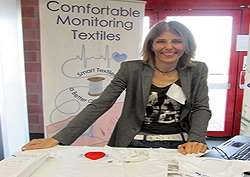Wireless monitoring of newborns

An Italian SME has developed a wearable monitoring system for babies as they go through the sensitive period of the first two to four hours of life. The technology, whose market potential has been assessed with funding under Horizon 2020, will help prevent critical situations while preserving the important skin-to-skin contact between mother and baby.
ComfTech, a neologism for 'comfortable technology', is an Italian SME specialising in the design and production of non-invasive wearable biomedical systems with sensors integrated in clothing. In January 2015 the company was granted EU support under Phase 1 of H2020's SME Instrument for NEWMOON (Smart Garments in Newborns and Babies Monitoring)—a non-invasive system for continuously monitoring newborns.
The new garment, which is a much needed alternative to repeated observation by nurses, could prove very valuable in guaranteeing immediate reactions in the event of an emergency, at the same time maintaining skin-to-skin contact between mother and child. Such contact has been demonstrated to positively affect the health of the baby, including his/her resistance to bacteria, body temperature stability, heart and breathing rates and even sugar levels in the blood. In comparison, a wire-based system would prevent these benefits and also be uncomfortable for the baby.
Alessia Moltani, CEO of ComfTech and coordinator of NEWMOON, gives an overview of the system's added value while detailing her plans for its future development.
The first two to four hours of life are the most sensitive for newborns. How is NEWMOON a game-changer in this regard?
Shortly after birth, for the first two to four hours, baby and mother stay in the delivery area: discontinuous monitoring is usually implemented through common visual recognition by the nursing staff. In this timeframe, during which the baby is in a transient state from pre- to post-natal, continuous monitoring of bio-signals can be very useful for preventing critical situations. The problem is that the traditional 'wired' monitoring systems are invasive and incompatible with the bonding procedure, as well as with the skin-to-skin contact between mother and baby which is considered to be of utmost importance. This is why most hospitals use these systems only for premature babies or if they foresee any risk for the newborn, and this means that the possibility of extending monitoring to all neonates is a real clinical challenge.
We developed our wearable monitoring system with three objectives in mind: the system would have to be accurate and reliable, comfortable and wireless with no impact on 'bonding moments', and very easy to use.
What is the added value of NEWMOON for medical staff?
The monitoring system aims to impact the organisation of the nursing staff's work, while increasing the quality of healthcare through the use of continuous quantitative monitoring rather than a qualitative observation repeated over time in a discontinuous manner.
It is important to note that the system has not been designed to avoid the visual monitoring recognition implemented by nurses, but rather to complement it with real data (ECG, respiration). In case of anomaly, the monitoring system immediately sends a notification to the caregiver.
Avoiding invasive monitoring was one of the key project objectives. How did you achieve that?
We actually worked on all three blocks in the system with the 'non-invasive' motto in mind. First of all the system is completely wireless, with the 'sensitex unit' being a garment with embedded textile sensors manufactured in soft cotton. The shape of the garment has been carefully studied in order to minimise impact during the skin to skin contact.
Next, the 'beat unit'—a small electronic device that collects the data in order to send it to caregivers via smartphones or hospital systems—is small and compact, and the case that protects the device is soft and covered with waterproof fabric.
Another key aspect is safety: the small electronic patch is rechargeable through induction, which is very important for guaranteeing the electrical safety of the baby, as it prevents any possible contact with the power source. Its case is waterproof and can be sterilised after each use.
Can you tell us more about the smart textiles you used and how they function?
Our company specialises in developing and manufacturing textile sensors for different products and purposes, including sports, wellness, automotive and toys. We start from developing the yarns, which gives us flexibility with the textile sensors technology.
In the NEWMOON project we used very small and soft sensors carefully embedded in the sleeves of the garment. The composition of the yarns and the texture of the sensors have been carefully studied in order to keep the sensors reliable and comfortable at the same time.
Price was a key point too, as the textile part is mono-use for hygiene reasons (ComfTech sensors can be washed, but for after-birth situations a mono-use garment is required).
Have you tested the device in hospitals yet? What can you tell us about the results?
ComfTech carried out the first clinical trial in the world to be approved by the Italian Ministry of Health and by the Hospital Ethical Committee 1, which studies the compliance, the acceptability and the reliability of any new monitoring system applied in the first two to four hours after birth.
The software for quick visualisation of all the data has also been discussed extensively with nurses in order for it to be easy and quick to use and to understand.
Provided by CORDIS



















